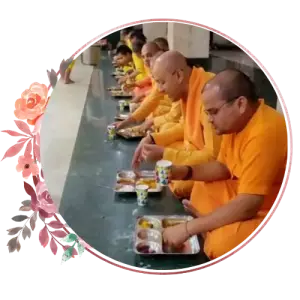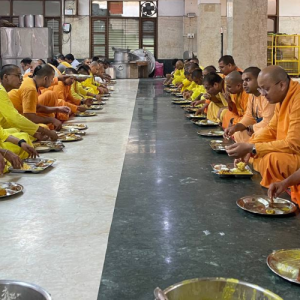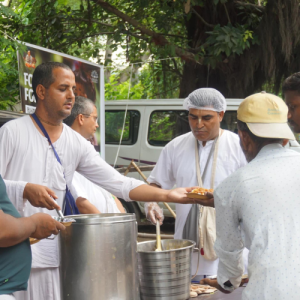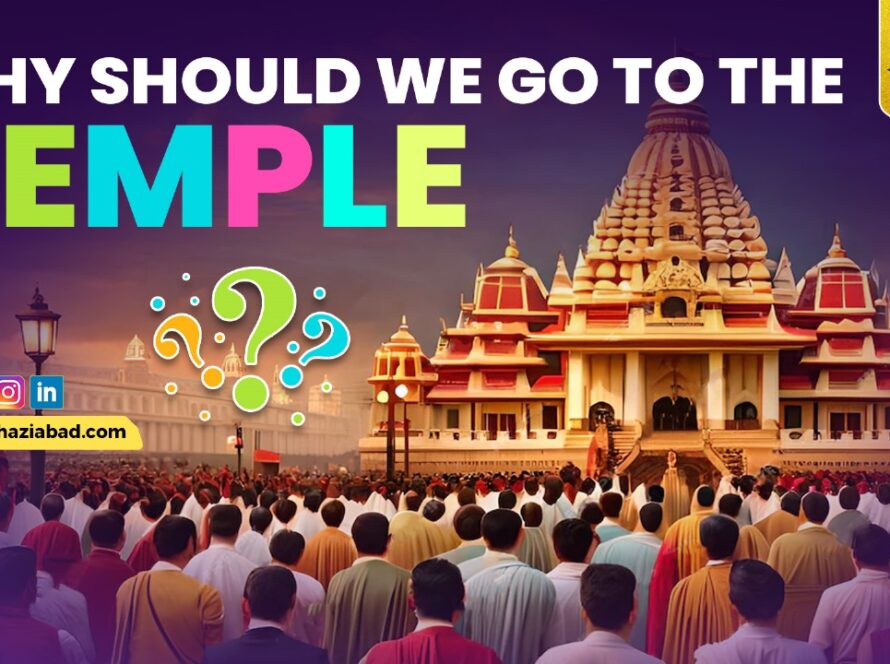Table of Contents
For centuries, Hindus have dreamed of building a grand temple for Lord Ram at the spot where he was believed to be born in Ayodhya. This dream became a major movement and struggle that lasted decades before finally being realized in 2020 with the beginning of construction on the Ram Mandir.
The construction of Radha Krishna temple has started again. Help us to build Radha Krishna temple.
Donate cement and Radha Naam Bricks and receive immense blessings from Shri Radha Krishna
“He who builds or helps in building a temple will save his father, grandfather and the eight tirthas of his ancestors from going to hell” – Vamana Purana.
Get Benefit Under 80G on Donations Made at ISKCON
The Roots of the Dispute
The conflict over the Ram Janmabhoomi site in Ayodhya dates back to 1528 when a mosque called Babri Masjid was built by the Mughal emperor Babur. Hindu groups believed this mosque was constructed after demolishing a temple that marked the birthplace of Lord Ram. This became the source of tension between Hindus and Muslims over the control of the site.
The Movement Gathers Steam
In the 1980s, the movement to reclaim the Ram Janmabhoomi site and allow the construction of a Ram temple gained immense momentum. The Vishwa Hindu Parishad (VHP) and BJP became leading voices in this movement. In 1992, kar sevaks or Hindu activists demolished the Babri Masjid, inflaming tensions across the country.
Court Battles and Negotiations
For the next few decades, the issue remained tied up in endless court battles and negotiations between Hindu and Muslim groups. In 2010, the Allahabad High Court ruled that the disputed land should be divided, with the Hindu and Muslim parties each getting a portion. This ruling failed to satisfy anyone.
Iskcon Ghaziabad distributes free meal to needy people everyday.
Join us by making a kind contribution to provide the prasadam to needy people.
Scriptures mention food (prasadam) distribution as one of the most charitable acts. Food (prasadam) distribution is a tradition that dates back to ancient times. Prasadam is infused with blessings. It not only nourishes the body but it energizes the soul one with unlimited blessings of Lord RadhaKrishna
Please donate generously and do not miss this unique opportunity to receive the unlimited blessings of Lord Krishna. Contribute to help us make this this occasion very special.
AVAIL 80G BENEFITS ON THE DONATIONS MADE TO ISKCON
Finally, A Resolution
In 2019, the Supreme Court stepped in and delivered a landmark verdict. It ruled that the entire disputed land should be handed over to a trust to build the Ram Mandir. Muslims were to be given an alternate 5-acre plot elsewhere in Ayodhya to construct a new mosque.
Construction Begins
After over 500 years of struggle, the construction of the grand Ram Mandir finally began in 2020 with a groundbreaking “bhoomi pujan” ceremony attended by Prime Minister Narendra Modi. The Ram Mandir is being built in the classical style of Hindu temple architecture and when completed, will be a three-storey stone structure with 5 domes or “shikharas.”
Sadhus are those who engage in the service of Lord Krishna and have surrendered completely themselves to Lord Krishna. They perform kirtans in temples and serve the societies by spreading the teaching of the Shrimad Bhagavad Gita.
Lord Krishna is more Pleased when sadhus are served. Kindly Donate to feed Sadhus and get the spiritual shower of blessing and success in your life.
AVAIL TAX BENEFITS UNDER 80G ON THE DONATIONS MADE TO ISKCON
A Moment Steeped in Faith and History
The beginning of construction on the Ram Mandir marked an event heavy with historical and religious significance for India’s majority Hindu population. For millions, it was the culmination of a dream that went back centuries. Those involved in the long struggle saw it as a testament to their unwavering faith and determination.
Critics Voice Concerns
However, the Ram Mandir movement was not without its critics. Many saw it as an attempt to impose Hindu majoritarianism over India’s secular ethics. There were concerns that the mosque demolition in 1992 set a dangerous precedent that could further inflame religious tensions. The Supreme Court verdict was seen by some as a judicial overreach in a matter tangled with faith and myth.
Looking to the Future
As the Ram Mandir takes shape, its supporters and the government have pledged communal harmony and urged Muslims to put the past behind them and embrace the temple for its national symbolism. Whether the Ram Mandir will usher in an era of religious unity or sharpen existing divides remains to be seen.
Where is Ram Mandir located in India
The grand Ram Mandir is being constructed in the city of Ayodhya in the northern Indian state of Uttar Pradesh. Ayodhya holds immense significance for Hindus as it is believed to be the birthplace of Lord Ram, the seventh avatar of Lord Vishnu.
On the Banks of the Saryu River
Ayodhya is an ancient city situated on the banks of the river Saryu, around 135 km from Lucknow, the capital of Uttar Pradesh. The old walled city with its numerous temples and ghats along the river is considered a holy site by millions of devout Hindus across India.
The Disputed Ram Janmabhoomi Site
The Ram Mandir is coming up at the Ram Janmabhoomi site which has been the center of a long-running dispute between Hindus and Muslims. Hindus believe this is the exact spot where Lord Ram was born eons ago in the Treta Yug. A mosque called the Babri Masjid stood at this spot until 1992 when it was demolished by Hindu kar sevaks claiming it was built by destroying an ancient Ram temple.
Supreme Court’s Landmark Verdict
In 2019, the Supreme Court handed over the entire 2.77 acre disputed site for the construction of the Ram Mandir, ending decades of court battles between the two communities. Muslims were allotted a separate 5-acre plot elsewhere in Ayodhya to build a new mosque.
Grand Plans for the Ram Mandir
The Ram Mandir is envisioned as a magnificent three-storey stone structure made of Rajasthan’s pink stone and adorned with extensive carvings. It will have five domes called ‘shikharas’ and several ornate ‘mandaps’ or pavilions. Computer renderings showcase a temple 268 feet long, 140 feet wide and 128 feet high with a Ram Murti seated inside the sanctum sanctorum facing east.
A Spiritual and Cultural Center
Along with the main Ram Mandir, the larger Ram Janmabhoomi complex will include several other temples, museums, study centers, and spaces for cultural activities. The tallest shikhar at a height of 260 feet will have a viewing gallery offering panoramic views of Ayodhya. Plans are also afoot to develop the entire region through a ‘Nav Ayodhya’ project that aims to recreate the grandeur of the Ram era in the city.
A Long Journey Ahead
While the groundbreaking bhoomi pujan ceremony took place in 2020, it may take at least another two years for the main Ram Mandir structure to be completed. Supporters and devotees have generously pitched in with contributions for the estimated Rs 1100 crore construction cost. However, given the scale and grandeur of the plans, the entire Ram Janmabhoomi complex may require many more years to fully take shape.
Pilgrims Pour In
Even before its completion, the Ram Mandir site is already drawing large numbers of pilgrims from across the country and abroad. For these devotees who undertake the “Ram Yatra” to Ayodhya, getting a glimpse of the sacred structure rising bit by bit is a profoundly moving spiritual experience. As the sanctum sanctorum takes shape, these pilgrimage numbers are only expected to grow exponentially.
A Confluence of Faith
Whether the construction of the Ram Mandir will bridge the communal divide or sharpen it remains to be seen. For now, the location of the grand Ram temple in the heart of the ancient holy city of Ayodhya is seen by believers as a convergence of faith, myth, and spiritual energies focused on the veneration of one of Hinduism’s most revered figures.
For now, for the millions who held the Ram Janmabhoomi movement close to their hearts, this is a moment of profound devotional rejoicing at seeing their dream take shape in brick, stone and devotional fervor.










